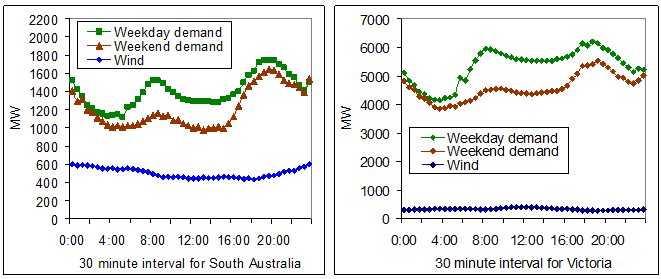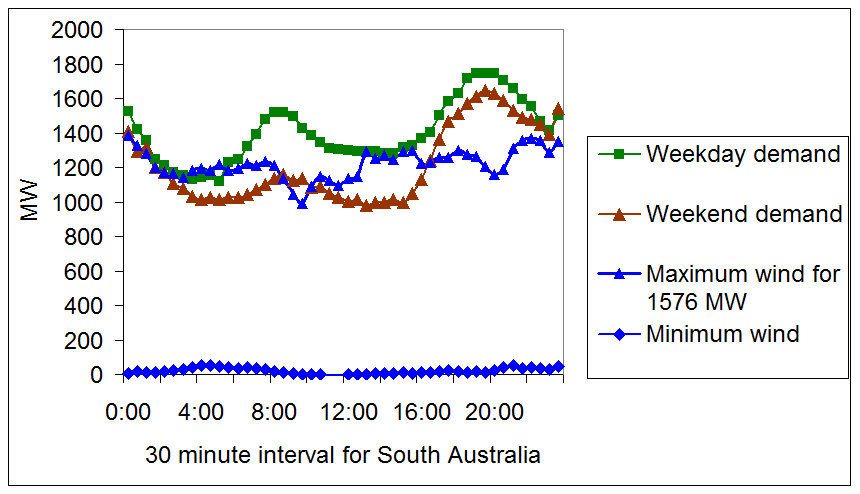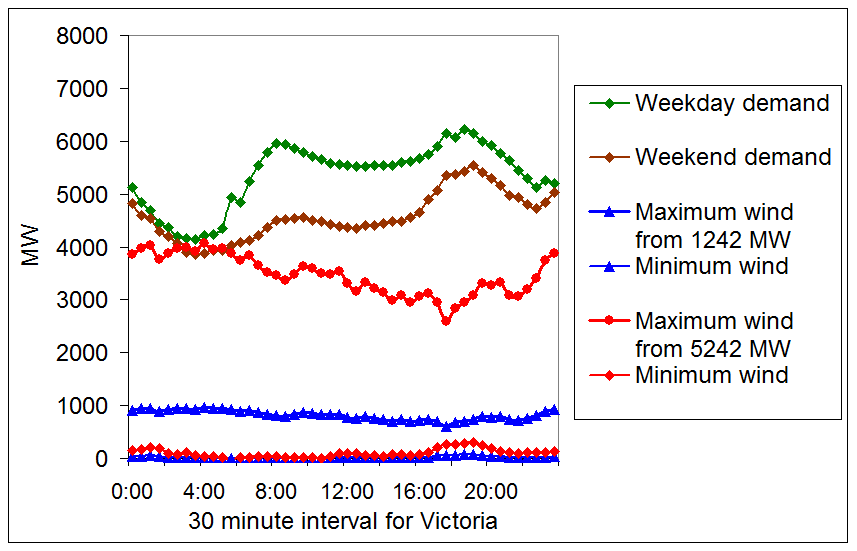
Figure 3:Average demand and wind supply in 30 minute intervals for 1 – 27 September 2016 for South Australia and 1 – 30 September for Victoria.
There appears to be a position for base load power in South Australia but this is closed off by the intermittent wind farm output. This is best shown by looking at the average demand and the wind farm maximum and minimum output plotted in Figure 4 where wind output can exceed demand on occasions as noted in Figure 1 where power is exported from South Australia to Victoria. These exports are at times of low demand in the early morning and serve to disrupt base load operation in Victoria.
Advertisement

Figure 4:Weekday and weekend demand and maximum and minimum wind supply for 1576 MW in 30 minute intervals for 1 – 27 September 2016 for South Australia.
For Victoria if a further 4000 MW of wind farms is added to supply then a situation similar to that of South Australia is possible as is shown in Figure 5. The maximum wind farm output is nearing the demand minimum and in addition the interconnectors to South Australia will add an extra intermittent need for power.

Figure 5:Weekday and weekend demand and maximum and minimum wind supply for 1242 MW and 5242 MW installed capacity in 30 minute intervals for 1 – 30 September 2016 for Victoria.
So for Victoria variations of supply will approach the situation in South Australia for load following. This would require the Victorian generators to cope with correlated variations in South Australia and Victoria with variations of as much as 3000 MW. Although the installed capacity of wind farms in New South Wales is only some 500 MW, these will also have a degree of correlation with the southern states so the system will need to be able to handle 4000 MW variations. This is the key question as load-following generators were developed to handle demand changes of 10's of MW per minute but, with the projected increase in wind farm installed capacity, the short term supply changes may increase to a requirement of 100's of MW per minute. The creation of more interstate transmission lines may not help when simultaneous variations in wind farm output occur in all the States.
Advertisement
The conclusion for the proposed Victorian increase in wind supply is that it will very much reduce the ability of the base load generators to supply low cost power but the government intention is to drive coal burning generators from the electricity market. This will add to industry costs and may drive some to seek lower cost power elsewhere. Worse may follow from the inherent instability of a system with a large supply of renewable energy. Industries needing reliable power may not be confident of its delivery or long term costs and as a consequence not establish or expand their operations in Victoria.
The real distortion to the system is the treatment of wind generated power. It is described as non-dispatchable (although some wind farms are now termed semi-dispatchable) as it must be used when generated. Wind farms do not bid a price into the wholesale market but rather take what is on offer and in addition collect a legislated subsidy of around $70 to $90 per MWh from distributors who pass this cost on to the users. The consequence of this is a distortion of the market that drives out high priced generators, such as the cleaner gas-fired plant, whose actual operating costs are less than the subsidy paid to the wind farms.
Discuss in our Forums
See what other readers are saying about this article!
Click here to read & post comments.
31 posts so far.
About the Authors
Tom Quirk is a director of Sementis Limited a privately
owned biotechnology company. He has been Chairman of the Victorian Rail Track
Corporation, Deputy Chairman of Victorian Energy Networks and Peptech Limited
as well as a director of Biota Holdings Limited He worked in CRA Ltd setting up
new businesses and also for James D. Wolfensohn in a New York based venture
capital fund. He spent 15 years as an experimental research physicist,
university lecturer and Oxford don.
Paul Miskelly is an electrical engineer who worked for ANSTO for 32 years.